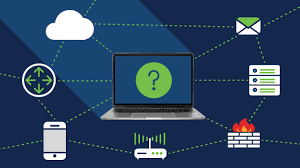In an increasingly interconnected business environment, ensuring robust network security is not just an operational priority—it is a strategic imperative. Enterprises must protect sensitive data, intellectual property, and critical infrastructure from evolving cyber threats. A layered, integrated approach to network security, underpinned by the right set of tools, is essential for maintaining trust, continuity, and regulatory compliance.
Outlined below are key categories of enterprise-grade network security tools and platforms that collectively support a proactive and resilient security architecture.
1. Network Monitoring Solutions: Foundation for Situational Awareness
Example Tool: ManageEngine OpManager
Proactive network monitoring is fundamental to maintaining the health, performance, and integrity of enterprise IT environments. Solutions like OpManager offer comprehensive visibility into the operational status of routers, switches, firewalls, servers, and virtual infrastructure. With features such as:
- Real-time fault detection and alerting
- WAN performance monitoring
- Wireless network diagnostics
Enterprises gain early warning signals of potential disruptions or malicious behavior, enabling timely intervention and minimizing downtime.
2. Network Protocol Analyzers: Deep Visibility for Forensic Insight
Example Tool: Wireshark
Protocol analyzers enable in-depth examination of network communications, essential for diagnosing performance issues and identifying anomalies. Wireshark, an industry-standard tool, provides:
- Real-time and offline packet analysis
- Support for hundreds of protocols
- Detailed session reassembly
Such granularity is critical for incident response teams and network engineers tasked with uncovering root causes of suspicious activity or degraded performance.
3. Intrusion Detection & Prevention Systems (IDPS): Active Threat Interception
Example Solution: Palo Alto Networks Next-Generation Firewall (NGFW)
Modern enterprises require IDPS capabilities that go beyond passive monitoring. Integrated into NGFWs, IDPS systems detect and block real-time threats using behavioral signatures, anomaly detection, and machine learning. Palo Alto’s platform delivers:
- Inline threat prevention
- Application-layer visibility
- Automated policy enforcement
By embedding IDPS within broader firewall strategies, organizations reduce time to detect and respond (TTDR) while maintaining compliance with industry frameworks like NIST and CIS CSC.
4. Next-Gen Firewall Platforms: Policy-Based Perimeter Defense
Example Solution: Netgate pfSense
Firewalls remain a cornerstone of network defense, evolving to handle more complex and dynamic environments. pfSense, an open-source and enterprise-grade solution, supports:
- Stateful packet inspection
- VPN integration
- Layered access control policies
For enterprises with hybrid and multi-site architectures, advanced firewall solutions ensure consistent policy enforcement and secure segmentation across diverse endpoints and data centers.
5. DNS Security Solutions: First Line of Threat Detection
Example Solution: DNSFilter
DNS remains a frequently targeted layer for phishing, command-and-control, and malware delivery. DNS security platforms like DNSFilter offer:
- Real-time threat categorization
- AI-driven domain reputation scoring
- Content filtering and access control
By monitoring and controlling outbound DNS requests, organizations can neutralize threats before they infiltrate internal systems—closing a critical security gap.
Strategic Takeaway: An Integrated Security Stack for a Distributed Enterprise
No single tool is sufficient to secure today’s dynamic enterprise networks. A robust security architecture requires a layered defense model that integrates:
- Visibility (Monitoring & Protocol Analysis)
- Prevention (IDPS & Firewalls)
- Containment (DNS & Traffic Segmentation)
CISOs and IT leaders should align tool selection with enterprise risk profiles, compliance obligations, and digital transformation goals. Ultimately, the integration of these tools into a unified security framework enhances the organization’s ability to detect, respond to, and recover from cyber incidents with confidence and speed.

